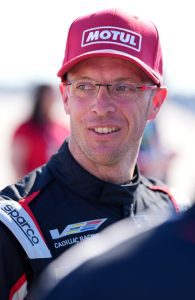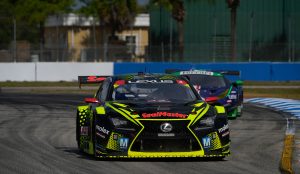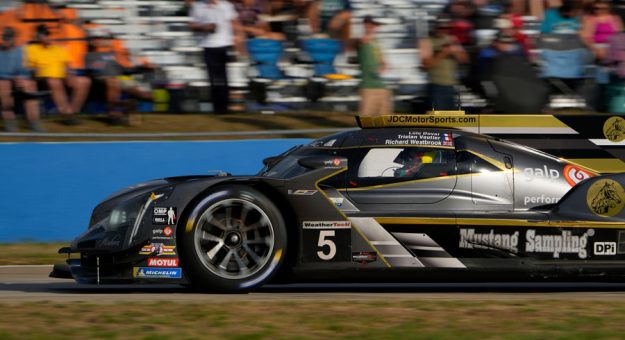Open-wheel racing and sports car racing often have significant crossover in talent, whether it be behind the wheel, behind the wrenches or behind various data screens.
After Brad Goldberg spent years at Chip Ganassi Racing as an engineer on the Ford GT program, he became Marcus Ericsson’s race engineer en route to winning the 2022 Indianapolis 500. At the same time, several drivers have moved from open-wheel racing to find success in sports cars.
Tristan Vautier’s racing career has, in a sense, come full circle.
The French racer was the 2011 champion of what was then known as the Star Mazda Championship on the Road to Indy with JDC Motorsports. Four years later, Vautier rejoined the renamed JDC-Miller Motorsports for the Rolex 24 at Daytona, finishing third in the Prototype Challenge class.
Four years after that, the 2012 Indy Lights champion rejoined JDC-Miller Motorsports in IMSA to race a Cadillac DPi as a customer team. Since their reunion in 2019, Vautier has one IMSA win at the 2021 12 Hours of Sebring with Loic Duval and fellow open-wheel racer Sebastien Bourdais.
But what happened before racing sports cars full time?
After winning the 2012 Indy Lights championship, Vautier received a scholarship check to take him to the IndyCar Series for the 2013 season, racing for what was then known as Schmidt Peterson Hamilton Motorsports (now Arrow McLaren SP). Vautier scored a season-best 10th-place finish at Barber Motorsports Park en route to being the de facto rookie of the year since he was the only rookie that season.
Vautier struggled as the season continued and finished 20th in the championship. Sponsor HP left the team after 2013, forcing Sam Schmidt to find a funded driver to partner Simon Pagenaud who was under contract with the team for 2014. After racing with the Road to Indy Scholarship money in 2013 and some smaller sponsorships to help fund his car, Vautier was out of a ride entering 2014.
“Then, all of a sudden, the team has money to fund just one car and there’s nothing on my side,” Vautier said. “And so I would say, I just kind of ran out of time and the timing just didn’t work out great.”

Vautier ran a partial IndyCar season in 2015 in the No. 19 Dale Coyne Racing Honda, beginning at that year’s Indianapolis 500. A fourth at Detroit and a sixth at Mid-Ohio were not enough to keep him in IndyCar for 2016, and as of press time Vautier’s last IndyCar start was at Texas Motor Speedway in 2017.
Vautier led 15 laps in that race before being caught up in a large accident during the second half of the race. This story is not unique to Vautier.
Several drivers that once raced in IndyCar have found a second home in IMSA. Those drivers’ skills should not be doubted in any way, shape or form.
“You’ve got a very large amount of drivers who are in IMSA who would compete at the front of the IndyCar field if they were given the right opportunity,” Vautier said. “And you know, most people in the industry are aware of that and I think for drivers, part of what attracts you (to IMSA) as a racing driver is the enjoyable part of driving the car, but it’s also the competition and racing, comparing yourself against the best and having to beat the best.”
Jack Hawksworth is another open-wheel driver who has found a second home in IMSA.
After winning the 2012 Star Mazda Championship, Hawksworth finished fourth in the 2013 Indy Lights championship before moving to IndyCar with Bryan Herta Autosport in 2014.
The British racer led the most laps at that year’s Grand Prix of Indianapolis before finishing seventh, also placing third at the second race on the streets of Houston.
Hawksworth then signed a two-year deal with A.J. Foyt Racing with mixed results, scoring five top-10 finishes in 2015 and no top-10s in 2016. After participating in four IMSA races in 2014, Hawksworth only competed in the Rolex 24 at Daytona in 2015 and ’16 because his contract would not allow him to race anything else during the IndyCar season.
That didn’t stop Hawksworth from finding a new deal when his Foyt contract ended. Hawksworth heard about Lexus starting a GT Daytona program for the 2017 IMSA season and made a couple of phone calls to get that seat with 3GT Racing. Despite showing brilliant pace in his rookie IndyCar campaign for a smaller team, Hawksworth, unfortunately, did not land a top-tier IndyCar ride.
Hawksworth races a Lexus RC F GT3 for Vasser Sullivan Racing, a team co-owned by Jimmy Vasser and James Sullivan. The partnership has paid dividends, with Hawksworth and co-driver Aaron Telitz winning the 2020 Sprint Cup for the GTD class.
Between 2019 and ’21, Hawksworth claimed six victories, a testament to his skills and his environment.
“For me, if you’re a good racing driver, you’re a good racing driver, you’ll probably be quick in any series in any car,” Hawksworth said. “But I think what’s been good for me over the last six or seven years is that I’ve had a lot of consistency in terms of the team I’m with, the people I’ve worked with, and I’ve been very lucky to work with a lot of good people over the last six years and build something and be a part of something which has been a lot of fun. And at the same time, I’ve been able to keep developing my skills as a driver.”
Vasser and Sullivan were both IndyCar team co-owners in the past, winning the 2013 Indianapolis 500 with Tony Kanaan driving. More recently, they co-owned the No. 18 Honda entry with Dale Coyne Racing. If Vasser and Sullivan wanted to return to IndyCar racing, Hawksworth would not turn down an opportunity to also return.
“I have a great relationship with Jimmy and Sulli and I think very highly of them,” Hawksworth said. “And I mean if it was going to be a proper program and we were going to go for it, then yeah, absolutely.”
While Vautier and Hawksworth are both in their early 30s and have a reliable window to go back to IndyCar, Bourdais is 43 and has embraced a return to an old mistress of his in sports car racing. Bourdais first ran in sports cars in 1999. En route to winning that year’s French Formula 3 championship, Bourdais raced in the 24 Hours of Le Mans after his father gave up his seat in a Larbre Competition Porsche so his son could compete.

While Bourdais climbed the open-wheel racing ladder into Formula 3000 and then into Champ Car, Formula1 and then IndyCar, sports cars were almost always in the background for the Le Mans native.
In fact, the only year since 1999 where Bourdais doesn’t have a sports car start was in 2008, the year he drove a full season for Scuderia Toro Rosso in Formula 1.
Bourdais grew up in the epicenter of sports car racing’s biggest event, with three overall runner-up finishes while racing for Peugeot in 2007, ’09 and ’11. In 2016, Bourdais scored a class win in GTLM with the Ford GT for Chip Ganassi Racing, but all of those results came while Bourdais was competing primarily in open-wheel racing.
The four-time Champ Car champion drove for the best team in that series, but never had the top-level ride on the IndyCar side of things following the 2008 Champ Car/IndyCar merger. A season and a half in Formula 1 and a couple of years of driving numerous cars across various championships kept Bourdais out of an IndyCar ride until a part-time opportunity showed up with Dale Coyne Racing in 2011.
In 2021, Bourdais drove the No. 14 A.J. Foyt Racing Chevrolet to top-five finishes at Barber Motorsports Park and WWT Raceway, but an eighth at Long Beach and a 10th at his American home race in St. Petersburg, Fla., were the only other bright spots in what was a disappointing season.
Nowadays, Bourdais keeps himself busy driving for Chip Ganassi Racing in the DPi class and will drive a new Cadillac V-LMDh machine for CGR next season.
“IndyCar has kind of, you know, naturally come to an end,” Bourdais said. “Never really got the timing and the shots that could have happened in IndyCar ever since I’ve come back to the U.S. in 2012 full time. Had some great moments and all, but like timing and contracts never really lined up for me to get another shot with a great organization capable of winning championships.”
Which really is the greatest shame for Bourdais, as his open-wheel pedigree is not in doubt. However, open-wheel racing’s loss is sports car racing’s gain as more and more drivers are able to show their skills in sports cars and let the racing world know that their talents are not in question.
